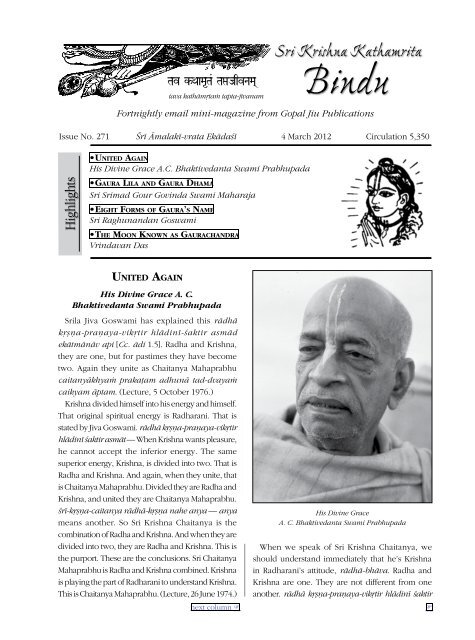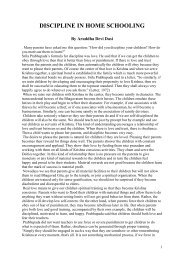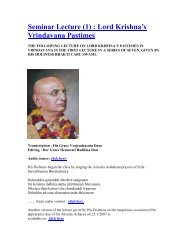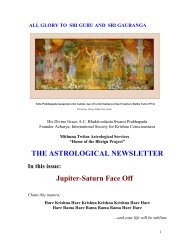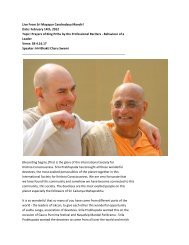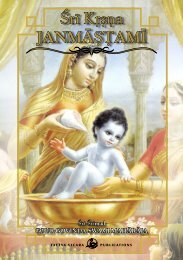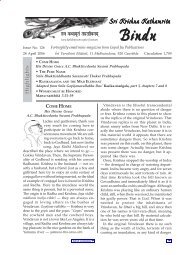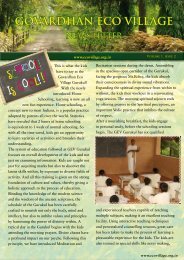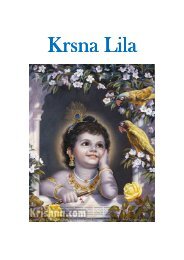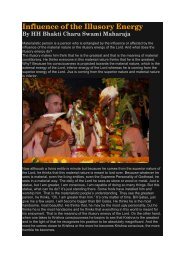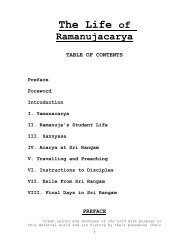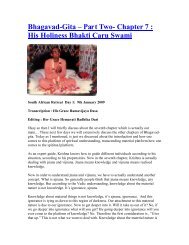Sri Krishna Kathamrita Bindu - GopalJiu.org
Sri Krishna Kathamrita Bindu - GopalJiu.org
Sri Krishna Kathamrita Bindu - GopalJiu.org
You also want an ePaper? Increase the reach of your titles
YUMPU automatically turns print PDFs into web optimized ePapers that Google loves.
Tav k QaaMa*Ta& TaáJaqvNaMa(<br />
tava kathämåtaà tapta-jévanam<br />
<strong>Sri</strong> <strong>Krishna</strong> <strong>Kathamrita</strong><br />
<strong>Bindu</strong><br />
Fortnightly email mini-magazine from Gopal Jiu Publications<br />
Issue No. 271 Çré Ämalaké-vrata Ekädaçé 4 March 2012 Circulation 5,350<br />
•United Again<br />
His Divine Grace A.C. Bhaktivedanta Swami Prabhupada<br />
Highlights<br />
•Gaura Lila and Gaura Dhama<br />
<strong>Sri</strong> <strong>Sri</strong>mad Gour Govinda Swami Maharaja<br />
•Eight Forms of Gaura’s Name<br />
<strong>Sri</strong> Raghunandan Goswami<br />
•The Moon Known as Gaurachandra<br />
Vrindavan Das<br />
United Again<br />
His Divine Grace A. C.<br />
Bhaktivedanta Swami Prabhupada<br />
<strong>Sri</strong>la Jiva Goswami has explained this rädhä<br />
kåñëa-praëaya-vikåtir hlädiné-çaktir asmäd<br />
ekätmänäv api [Cc. ädi 1.5]. Radha and <strong>Krishna</strong>,<br />
they are one, but for pastimes they have become<br />
two. Again they unite as Chaitanya Mahaprabhu<br />
caitanyäkhyaà prakaöam adhunä tad-dvayaà<br />
caikyam äptam. (Lecture, 5 October 1976.)<br />
<strong>Krishna</strong> divided himself into his energy and himself.<br />
That original spiritual energy is Radharani. That is<br />
stated by Jiva Goswami. rädhä kåñëa-praëaya-vikåtir<br />
hlädiné çaktir asmät — When <strong>Krishna</strong> wants pleasure,<br />
he cannot accept the inferior energy. The same<br />
superior energy, <strong>Krishna</strong>, is divided into two. That is<br />
Radha and <strong>Krishna</strong>. And again, when they unite, that<br />
is Chaitanya Mahaprabhu. Divided they are Radha and<br />
<strong>Krishna</strong>, and united they are Chaitanya Mahaprabhu.<br />
çré-kåñëa-caitanya rädhä-kåñëa nahe anya — anya<br />
means another. So <strong>Sri</strong> <strong>Krishna</strong> Chaitanya is the<br />
combination of Radha and <strong>Krishna</strong>. And when they are<br />
divided into two, they are Radha and <strong>Krishna</strong>. This is<br />
the purport. These are the conclusions. <strong>Sri</strong> Chaitanya<br />
Mahaprabhu is Radha and <strong>Krishna</strong> combined. <strong>Krishna</strong><br />
is playing the part of Radharani to understand <strong>Krishna</strong>.<br />
This is Chaitanya Mahaprabhu. (Lecture, 26 June 1974.)<br />
next column <br />
His Divine Grace<br />
A. C. Bhaktivedanta Swami Prabhupada<br />
When we speak of <strong>Sri</strong> <strong>Krishna</strong> Chaitanya, we<br />
should understand immediately that he’s <strong>Krishna</strong><br />
in Radharani’s attitude, rädhä-bhäva. Radha and<br />
<strong>Krishna</strong> are one. They are not different from one<br />
another. rädhä kåñëa-praëaya-vikåtir hlädiné çaktir
Issue Two Hundred Seventy-one, Page — 2<br />
top left 2<br />
asmäd [Cc. ädi 1.5] — Radharaëi is the expansion of<br />
<strong>Krishna</strong>’s pleasure potency. So Çri <strong>Krishna</strong> Chaitanya<br />
Mahaprabhu is <strong>Krishna</strong> himself, but the pleasure<br />
potency of <strong>Krishna</strong> is prominent in his activities.<br />
<strong>Krishna</strong>, in order to understand himself, took the<br />
position of Radharaëi. Personally he could not<br />
understand his potencies, but when he appeared as<br />
<strong>Sri</strong> <strong>Krishna</strong> Chaitanya Mahaprabhu in the attitude of<br />
Radharani’s love for <strong>Krishna</strong>, kåñëa-prema, then he<br />
could fully understand himself as <strong>Krishna</strong>. These are<br />
very intricate subject matters to understand, but this<br />
is the fact. (Lecture, 3 March 1974.) ·<br />
Top right 2<br />
é[q k* Z
<strong>Sri</strong> <strong>Krishna</strong>-kathamrita <strong>Bindu</strong> top right Issue 3 Two Hundred Seventy-one, Page — 3<br />
Top left 3<br />
So vraja-lélä is kåñëa-lélä and navadvépa-lélä is also<br />
kåñëa-lélä. Of these two types of léläs, one is manifested,<br />
prakaöa, and the other is unmanifested, aprakaöa.<br />
What is Nabadwip Dham? Äcäryas and mahäjanas<br />
have said that it is a closed compartment in Vraja<br />
Dham. So Vraja Dham is of two types — prakaöa<br />
and aprakaöa, manifest and unmanifest.<br />
In that closed compartment known as Nabadwip<br />
Dham, <strong>Krishna</strong>, who is rasaräja, the chief of all<br />
enjoyers of mellows, is feeling acute pangs of<br />
separation, viraha, from Radharani, and he cries<br />
and cries and cries. He had developed greed to<br />
understand the feelings of Radharani, to understand<br />
his own beauty, and to understand the happiness<br />
that Radharani feels by enjoying his beauty.<br />
He had developed these three desires and was<br />
thinking of how to fulfill them. He concluded that<br />
without accepting the sentiment and complexion of<br />
Radharani, his greed could not be satisfied. Therefore<br />
he entered into the core of the heart of Radharani<br />
and hid himself there, and a molten gold complexion<br />
manifested outwardly. So externally he is feeling the<br />
pangs of separation, but in the heart there is union.<br />
In that separation, viraha, vipralambha-bhäva, he<br />
chants the name of <strong>Krishna</strong>, “hare kåñëa hare kåñëa<br />
kåñëa kåñëa hare hare hare räma hare räma räma<br />
räma hare hare". Similarly, in Rädhä-tantra it is<br />
described that in Vrajabhumi, when Radharani feels<br />
acute pangs of separation from <strong>Krishna</strong>, she chants<br />
the name of <strong>Krishna</strong>. Mahaprabhu accepted the<br />
same rädhä-bhäva and rädhä-känti. So, absorbed<br />
in vipralambha-bhäva, Gaura chants the hare kåñëa<br />
mahä-mantra.<br />
That hidden Vrindavan is Nabadwip Dham,<br />
a closed compartment in Vrindavan. Where is<br />
Nabadwip and where is Vrindavan? They are so far<br />
apart, hundreds and hundreds of miles apart. That<br />
is external. But if you have an internal vision, you<br />
will see that one is inside the other, Nabadwip is<br />
inside of Vrindavan. Therefore, the äcäryas instruct<br />
us not to see any difference between gaura-vana<br />
and vraja-vana. We sing that song by <strong>Sri</strong>la Narottam<br />
Das Thakur:<br />
gauräìgera saìgi-gaëe, nitya-siddha kari’ mäne,<br />
se yäya vrajendra-suta päça<br />
çré-gauòa-maëòala-bhümi, yebä jäne cintämaëi<br />
tära haya vraja-bhüme väsa<br />
<br />
<strong>Sri</strong> Chaitanya Mahaprabhu's original shoes and<br />
waterpot preserved in the Gambhira in Jagannath Puri<br />
One who accepts the associates of Lord Chaitanya<br />
Mahaprabhu as nitya-siddhas is certain to be elevated<br />
to the spiritual kingdom to become an associate of the<br />
Supreme Lord. One should also know that Gaudamandala-bhumi<br />
— those places in Bengal where <strong>Sri</strong><br />
Chaitanya Mahaprabhu stayed — are equal to Vrajabhumi<br />
Vrindavan. There is no difference between the<br />
inhabitants of Vrindavan and those of Gauda-mandalabhumi,<br />
<strong>Sri</strong>dham Mayapur. Therefore, no one should<br />
see any difference between Gaura and <strong>Krishna</strong>. ·<br />
— From a Gaura-Pürëimä lecture, Bhubaneshwar, 3 March 1994.<br />
Eight Forms of Gaura’s Name<br />
<strong>Sri</strong> Raghunandan Goswami<br />
The following verse gives Gaura’s name in the eight<br />
cases of Sanskrit Grammar:<br />
gauraù sac-caritämåtämåta-nidhir<br />
gauraà sadaiva stuve<br />
gaureëa prathitaà rahasya-bhajanaà<br />
gauräya sarvaà dade<br />
gauräd asti kåpälur atra na paro<br />
gaurasya bhåtyo ’bhavam<br />
gaure gauravam äcarämi bhagavan<br />
gaura prabho rakña mäm<br />
(1) Gauraù — Gaura’s ecstatic transcendental<br />
pastimes are like an ocean of nectar. (Gaura<br />
as the subject)<br />
(2) Gauram — It is Lord Gaura who is eternally<br />
worshipable. (Gaura as the object)<br />
(3) Gaureëa — It is through Gaura that the<br />
confidential secrets of kåñëa-bhajana were<br />
revealed. (Gaura as the instrument of action)<br />
(4) Gauräya — Unto Gaura everything should be<br />
given. (Gaura as the recipient of action)<br />
(5) Gaurät — No one is more merciful than Gaura.<br />
(Gaura in a comparative sense)<br />
(6) Gaurasya — I will become a servant of Gaura.<br />
(Gaura in a relationship)
Issue Two Hundred Seventy-one, Page — 4<br />
Top left 4 Top right 4<br />
(7) Gaure — I shall always act by investing all my<br />
pride in Gaura. (Gaura as the reservoir of a quality)<br />
(8) Gaura — O Gaura! My Lord! Please protect me!<br />
(Gaura being addressed directly). ·<br />
— Çré Gauräìga Virudävalé 110. Mrinalakanti Ghosh (editor).<br />
Çré Gaura-pada-taraìgiëé. <strong>Sri</strong> Gauranga Press. Calcutta. 1903.<br />
Bengali. Page 15.<br />
The Moon Known as Gaurachandra<br />
Vrindavan Das<br />
jaya jaya rava bhela nadéyä nagare<br />
janmilena çré-gauräìga jagannätha ghare<br />
jagan-mätä çacé-devé miçra jagannätha<br />
mahänande gagana päola janu häta<br />
The town of Nadia reverberated with the sounds<br />
of ‘Jaya! Jaya!’ It was the occasion of the birth of <strong>Sri</strong><br />
Gauranga, who appeared at the home of Jagannath<br />
Misra. Mother Sachi, who was like the mother of the<br />
entire world, and Jagannath Misra raised their hands<br />
in the sky in their great ecstasy.<br />
grahaëa samaye pahuì äélä avané<br />
çaìkha-näda hari-dhvani cäri bhite çuni<br />
nadéyä nägaré-gaëa deya jaya-kära<br />
ulu-dhvani hari-dhvani änanda apära<br />
As the time for the lunar eclipse approached,<br />
loud sounds of conch shells and the chanting of the<br />
holy names of Lord Hari could be heard in all four<br />
directions. The residents of Nadia loudly chanted, “Jaya!<br />
<strong>Sri</strong> <strong>Krishna</strong> <strong>Kathamrita</strong> <strong>Bindu</strong><br />
A free bi-monthly service provided by:<br />
Gopal Jiu Publications<br />
c/o <strong>Sri</strong> <strong>Krishna</strong> Balarama Mandir<br />
National Highway No. 5, IRC Village<br />
Bhubaneswar, Odisha, India, 751015<br />
Phone: (0674) 2553250, 2557026<br />
Email: katha@gopaljiu.<strong>org</strong><br />
Website: www.gopaljiu.<strong>org</strong><br />
Subscriptions: minimag@gopaljiu.<strong>org</strong><br />
Gopal Jiu Publications is a branch of the International<br />
Society for <strong>Krishna</strong> Consciousness, Founder-Acharya: His<br />
Divine Grace A.C. Bhaktivedanta Swami Prabhupada.<br />
Quotations from the books, letters, and lectures of His Divine Grace A.<br />
C. Bhaktivedanta Swami Prabhupada ©Bhaktivedanta Book Trust<br />
International. All other materials, unless specified, © ISKCON<br />
Bhubaneswar/Gopal Jiu Publications. All rights reserved. Blanket<br />
permission is given to redistribute <strong>Bindu</strong> in electronic or print<br />
form provided no changes are made to the contents.<br />
<br />
The moonlike Gaurachandra<br />
é[q k* Z


